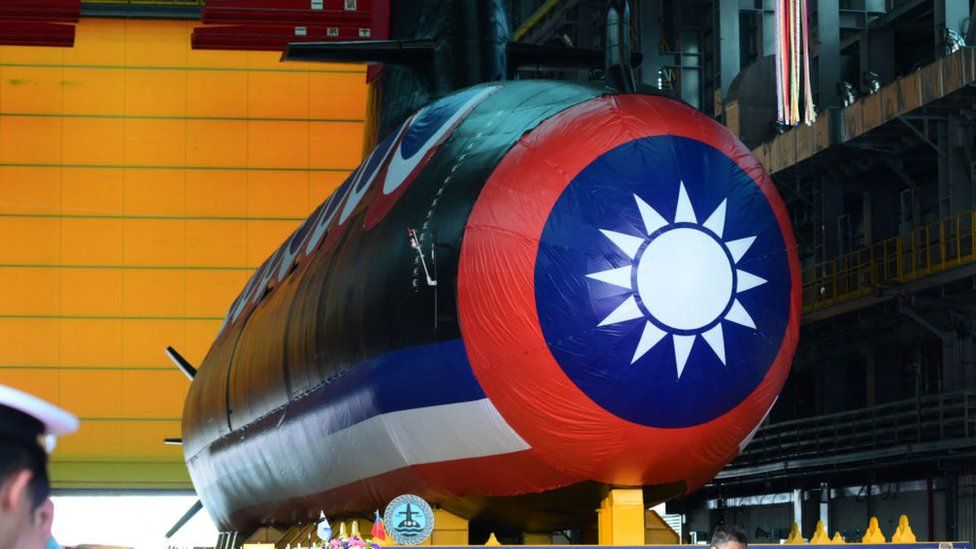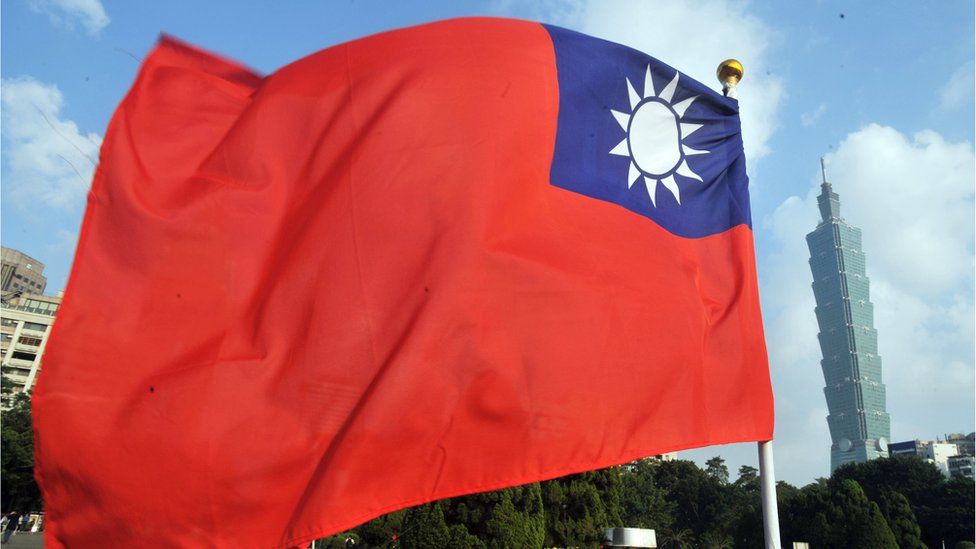
Taiwan has unveiled its first domestically-made submarine as it bolsters its defences against a possible Chinese attack.
President Tsai Ing-wen presided over the launch ceremony in the port city of Kaohsiung on Thursday.
US officials have warned that China could be militarily capable of mounting an invasion within the next few years.
Taiwan is a self-governing island which China regards as a renegade province and has vowed to reclaim one day.
Most observers believe China will not attack the island imminently, and Beijing has said it seeks peaceful “reunification” with Taiwan.
But at the same time it has warned against Taiwan formally declaring independence and any foreign support. It has increasingly sought to put pressure on the island with its military drills in the Taiwan Strait, including several conducted this month.
Following the launch, Taiwan’s $1.54bn (£1.27bn) diesel-electric powered submarine will undergo several tests and will be delivered to the navy by the end of 2024, according to military officials.
It has been named the Haikun after a mythical massive fish that can also fly, which appears in classic Chinese literature.
Another one is currently in production. Taiwan aims to eventually operate a fleet of 10 submarines – including two older Dutch-made boats – and equip them with missiles.
The head of the domestic submarine programme Admiral Huang Shu-kuang told reporters last week that the goal was to fend off any attempt from China to encircle Taiwan for an invasion or impose a naval blockade.
It would also buy time until US and Japan forces arrive to aid Taiwan’s defence, he added.
Building their own submarines has long been a key priority for Taiwan’s leaders, but the programme accelerated under Ms Tsai who has revved up military spending to nearly double its budget during her tenure.
China has yet to respond officially. But in a piece published earlier this week, state media outlet Global Times said Taiwan was “daydreaming” and the plan was “just an illusion”.
It also claimed China’s military “has already constructed a multidimensional anti-submarine network all around the island”.
Observers agree that the new submarines could help boost Taiwan’s defence.
Taiwan’s 10-submarine fleet would pale in comparison to China’s, said to currently comprise more than 60 boats including nuclear-powered attack submarines, with more on the way.
But the island has long pursued an asymmetric warfare strategy where it aims to build a more agile defence force to face down a larger and well-resourced enemy.
The submarines could “aid Taiwan’s relatively small navy in taking initiative against China’s mighty navy” by conducting “guerrilla style warfare with their stealth, lethality and surprise capabilities”, noted William Chung, a military researcher with the Institute for National Defense and Security Research in Taiwan.
In particular, he said, they could help guard the various straits and channels that link the so-called “first island chain”, a network of islands including Taiwan, Philippines and Japan seen as a possible battlefront for any conflict with China.
Anti-submarine warfare remains as the Chinese navy’s “weakest part, and this is the chance for Taiwan to exploit it,” he added.
But the “centre of gravity” for any China-Taiwan naval conflict would not likely take place in the deep waters off the island’s east coast, where submarines would be most effective in, pointed out Drew Thompson, a visiting senior research fellow at the National University of Singapore and former US Department of Defense official.
Instead, the main theatre of war would be in the shallower waters of the west coast facing mainland China.
“The submarine is not optimised for a counter invasion role… having this increased capability to complicate China’s military operations would have an effect, but it’s not a decisive one,” he said.
Their effectiveness would largely depend on how Taiwan chooses to deploy them.
Beyond playing a deterrent role they could also be used to ambush Chinese ships; carry out mine-laying operations in Chinese ports; disrupt maritime oil supplies; and destroy key facilities on the Chinese coastline, according to Chieh Chung, a defence researcher with Taiwanese think tank National Policy Foundation.
What is more significant, however, is that Taiwan managed to design and build its own submarine in the first place.
The Haikun uses a combat system by US defence company Lockheed Martin and will carry US-made missiles. While this may be no surprise given that the US is Taiwan’s chief ally, at least six other countries including the UK came to Taiwan’s aid in supplying components, technology and talent, according to a Reuters report.
Adm Huang told Nikkei Asia he had personally approached military contacts in the US, Japan, South Korea and India for help but did not specify which country eventually agreed.
The fact that several countries and companies were “not afraid to supply parts to a marquee defence programme in Taiwan… indicates a significant geopolitical shift,” noted Mr Thompson.
It is an indicator of the “doubt and dissatisfaction” with Beijing felt by some members of the international community, and “should cause China to feel disquiet”, added Mr Chieh.
The launch comes a day after Beijing confirmed it had been conducting military drills this month to “resolutely combat the arrogance of Taiwan independence separatist forces”.
In recent weeks it had once again ramped up its warship presence in the Taiwan Strait and military jet incursions into airspace around the island.
US military and intelligence officials have given varying timelines for a possible Chinese invasion.
One date put forth recently is 2027 – Chinese President Xi Jinping is believed to have told his military to be operationally capable of mounting an invasion by that year.
But CIA director William Burns also said it did not necessarily mean Mr Xi would decide to invade then as he is thought to have doubts over whether China would succeed.
Related Topics
-
-
2 August 2022

-


